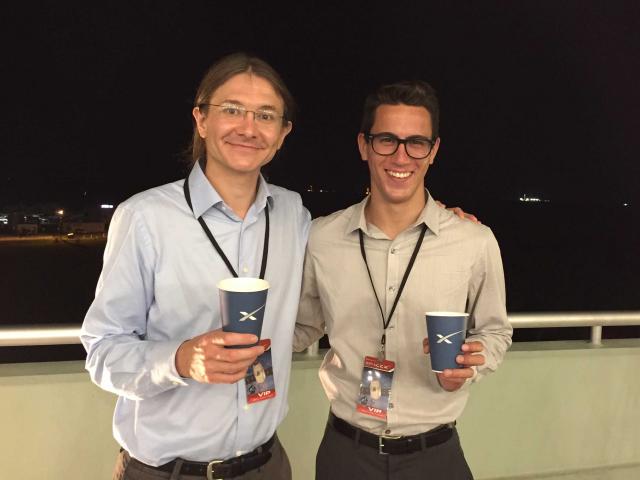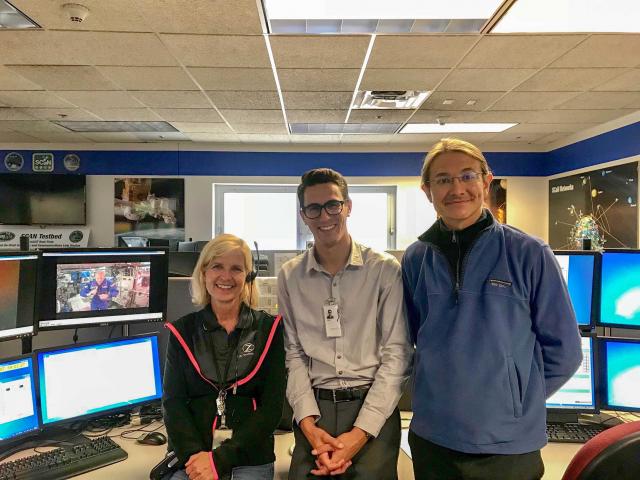Clay in Space
Fourth-year CCS Physicist Nick Rommelfanger sends his cohesive sediment experiment to the International Space Station
By Will Proctor

Nick Rommelfanger’s heart sped up as the SpaceX Falcon 9 rocket lifted off from the Kennedy Space Center in Cape Canaveral, Florida on June 29. The fourth-year CCS Physicist had witnessed launches before, but this time it was personal. The experiment he had worked on for countless hours over the past year was riding aboard the rocket heading to the International Space Station (ISS).
The experiment is part of a project pursued in Professor Paolo Luzzatto-Fegiz’s Fluid Energy Science Lab and is focused on the inter-particle forces found in cohesive sediment, otherwise known as clay. This has a variety of critical real-world consequences. “Understanding the strength of inter-particle forces is crucial to predicting sediment transport processes, such as the evolution of rivers and estuaries,” explained Rommelfanger. “It can also point to productive oil drilling sites, making the drilling process more efficient and consequently safer for the environment.”
Rommelfanger was one of the few lab members who traveled to Florida to witness the launch and was helpful in communicating the lab’s research to the public. “I was grateful to be invited by Professor Luzzatto-Fegiz to join him at the launch at Kennedy Space Center, and I've been excited to share information about our experiment with many of the people here.” He was even featured on the National Science Foundation's Instagram story.
“Nick's extensive work on the ground-based experiments has been crucial to readying our experiment for launch,” said Professor Luzzatto-Fegiz. “There are virtually infinite combinations of clay types, sand, and salinity that we could test, and we could only send ten samples. Nick's lab results have already resolved important questions in sediment transport, and enabled us to move onto testing more complex hypotheses through the space experiments. I have been continuously impressed by Nick's skills and dedication, and by the level of training, motivation and support he has been receiving through CCS.”
When studying cohesive sediment on Earth, gravity complicates the interpretation of the experimental results. “Gravity masks the effects of these inter-particle forces in a lab,” Rommelfanger said. “Clay settles to the bottom of a container relatively quickly when suspended in water.” Although Professor Luzzatto-Fegiz’s team was able to learn background information from the earth-based experiments that occurred in the year prior to the launch, the scientists will receive the crucial data from the completion of the experiment on the ISS.

A few days after the launch, the study was safely on board the ISS. Several weeks later, it was time to begin the experiment. On the morning of July 26, Rommelfanger and Professor Luzzatto-Fegiz traveled to NASA’s Glenn Research Center in Cleveland, Ohio to assist German Astronaut and Geophysicist Alex Gerst with the setup of the experiment. Collaborating with an astronaut on the ISS was even more incredible to Rommelfanger than watching the launch. “I've spent lots of time working on our setup at a lab bench on campus, so watching an astronaut floating around and working on a duplicate of the setup aboard the ISS was surreal,” noted Rommelfanger.
The CCS student played an essential role in the operations of the setup on the ISS. “There were several decisions that Professor Luzzatto-Fegiz and I needed to make to help the astronaut overcome issues he encountered as he moved through the setup procedure,” remembered Rommelfanger. “We needed to discuss our options and come to decisions quickly to save time and frustration for the astronaut.” Aided by NASA’s “terrific” ground control teams, Rommelfanger and Professor Luzzatto-Fegiz overcame a few taxing moments and executed the setup successfully. Rommelfanger said: “The setup this morning was both very exciting and at times nerve-racking. At the end of the day, everything went well.”
Rommelfanger had worked on other projects during his first couple of years at UC Santa Barbara. This previous research experience prepared him to make a meaningful impact on the ISS project from the moment he joined. “I've run the majority of our earth-bound test experiments for the past nine months,” said Rommelfanger. “The data I collected helped us make a decision on which samples we should send to the ISS.” Rommelfanger credits CCS with pushing him to make meaningful contributions in the lab. He added: “The guidance of my advisor and our fantastic CCS lab courses put me in a great position to become involved in exciting research.”
“Nick is a leader of the most stellar group of students I have ever worked with,” said Dr. Tengiz Bibilashvili, Rommelfanger’s CCS Faculty Advisor. “From the very beginning, he achieved a deep understanding of fundamental principles of Physics by staying after my lectures to independently re-derive what I explained in class. Nick is also a productive member of the CCS community, always taking the initiative to host prospective students. One of these students told me that his goal in CCS is to be like Nick.”
Rommelfanger plans to pursue a Ph.D. after graduating from CCS. Assisting in this ground-breaking project has given him confidence that he can succeed in research no matter what the lab throws at him. “Working on this project has shown me that research is exciting at some points and very tedious at others, but putting in time in the lab through successes and failures will keep you moving forward and learning,” he noted. “I feel comfortable going into graduate research having learned so much about the scientific process from this experiment and my amazing group members.”
_______________________
Contact
(805) 893-2035
will.proctor@ccs.ucsb.edu